How to Increase the Average Order Value for Your Ecommerce Store
As an ecommerce shop, you need to keep coming up with new ways to increase your revenue.
But it’s a common misconception that you need to find new customers to generate more sales. That’s not the case.
In fact, there are plenty of ways to increase revenue without acquiring new customers.
Rather than trying to get more transactions on your ecommerce site, you should be focusing on tactics that increase the amount of each transaction.
Don’t get me wrong. Obviously, new customers and more transactions are great news for your business. But it’s not the only way to make more money.
What’s the average order value on your platform?
You should be tracking this metric at all times. If you’re unfamiliar with average order value, abbreviated as AOV, it’s really easy to calculate.
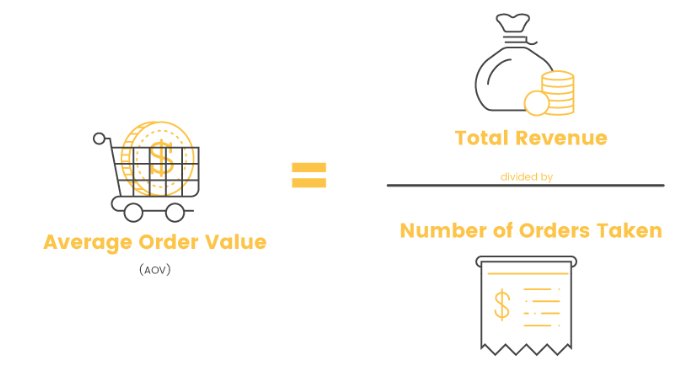
Tactics that improve your AOV work for new as well as existing customers.
It’s all about the way you display information on your website.
I know what some of you might be thinking. Your current average order value is adequate. Do you really need to make any changes?
Absolutely.
When it comes to an AOV, there is always room for improvement. In truth, the sky is the limit.
Use this guide as a reference for increasing your AOV. Once you apply these strategies, your ecommerce revenue will increase as a result.
Set a minimum for free delivery
Free delivery has a major impact on ecommerce conversions.
In fact, 60% of consumers will abandon their shopping carts during the checkout process if they’re presented with extra costs, such as shipping.
I’m a big advocate of not passing those shipping costs onto your customers.
That said, you don’t need to offer free shipping on every order. Here’s what I mean.
At the end of the day, someone has to pay for shipping. It’ll either be you or the customer.
Just include those shipping costs in the cost of your products.
That way, shipping is perceived as free to the customer, but you’ll still be able to cover those costs with their purchase.
If you want to increase the average order value, set a minimum purchase amount for free shipping eligibility.
REI uses this strategy:
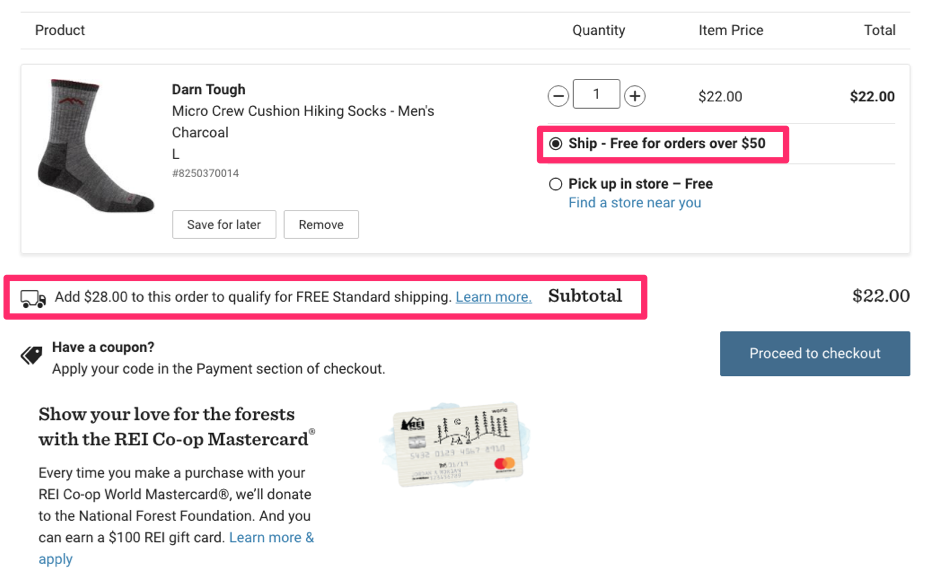
Take a look at this shopping cart.
The total cost of the products in the cart is $22. But this total isn’t enough to be eligible for free shipping.
REI reminds its customers in two places on this page that orders over $50 ship free.
As a result, people will be more inclined to add additional items to their carts.
Why pay for shipping if you don’t have to?
Assuming the customer in this scenario took the bait, REI was able to increase the purchase amount of this transaction by more than double the initial value.
Upsell on the checkout page
The most successful ecommerce shops find ways to upsell to their customers right before they finalize the purchase.
However, you need to be careful if you decide to implement this strategy. Here’s why.
Upsells shouldn’t take away from the initial purchase intent.
By the time your customers reach your checkout page, they already added items to their carts and want to convert. Don’t let your upsell be a distraction that eventually hinders them from completing the purchase.
The buying process needs to be as fluid as possible, with minimal friction. So don’t make the upsell an extra step.
Let me show you a great example of an upsell from Jetties Bracelets that illustrates what I’m talking about:
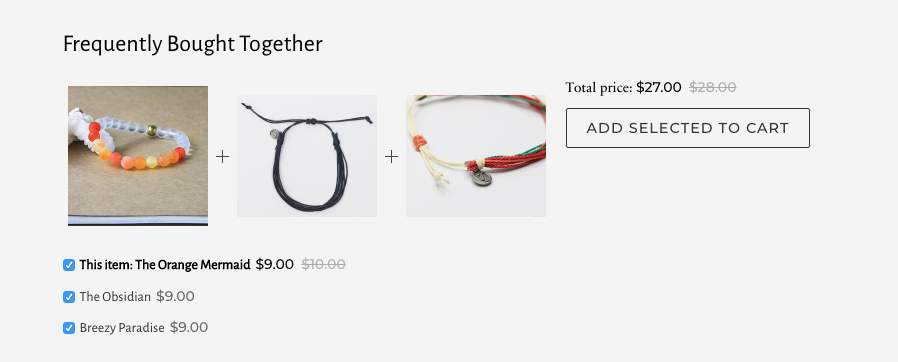
Based on what the customer added to their shopping cart, the website automatically generated an upsell of other items frequently purchased together.
If the customer wants to add these upsells to their cart, all they need to do is click one button.
This takes the value of this order from $9 to $27.
As you can see, a simple upsell on the checkout page can triple the order amount. Just make sure it isn’t distracting or forced upon the customer.
You want them to convert even if they don’t go for the upsell.
Offer package discounts
Bundle or package discounts provide an incentive for customers to spend more money.
The concept behind this tactic is simple.
You can generate more profits by focusing on your pricing strategy. Most pricing models make it more expensive to buy a single item.
But if the customer is willing to buy higher quantities of that item, they’ll receive a discount depending on how much they’re willing to spend.
It’s the basic strategy behind “buying in bulk,” which is common for B2B companies.
However, you can apply the same method to your B2C ecommerce shop. Customers shouldn’t have to buy thousands of instances of the same product to get a quantity discount.
Look at how MeUndies accomplishes this:
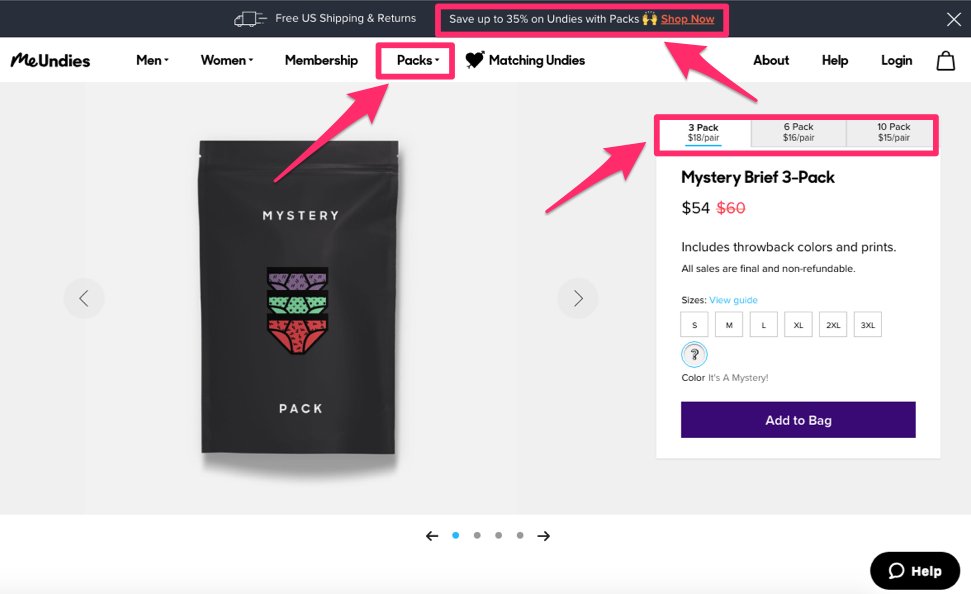
The brand uses this strategy all over its ecommerce site.
For starters, it advertises that customers can save up to 35% off by purchasing packs.
Then, if you look at the site’s navigation menu, you’ll see that “packs” is one of the five options for segmenting products.
The company reinforces these discounts when a customer clicks on a pack to purchase.
For this pack of underwear, MeUndies offers a discount for buying three pairs instead of one.
However, if the customer buys a 6-pack, the cost per pair goes down even more. Customers will benefit from additional savings if they buy a 10-pack.
The price of one pair of underwear is $20. But in a 10-pack, it’s $15 per pair.
This strategy encourages people to spend more money because it makes them feel they’re getting a better value.
Customers can get a 25% discount by spending more money. As a result, you’ll benefit from getting a higher average order value.
Include a gift wrap option
Another way to increase the AOV of your ecommerce shop is by enhancing the value of your products.
What can you do to make your products more valuable?
One strategy I like is the gift wrap option.
During the holidays, 82% of shoppers plan to buy gifts online. But holidays aren’t the only time of the year when people buy gifts.
People get gifts for birthdays, weddings, graduations, retirements, and other milestones. Your gift wrapping feature should be available 365 days a year.
Look at how Target uses this strategy on its ecommerce store to increase its AOV:

On the checkout page, shoppers can indicate whether their order includes a gift.
If the buyer wants gifts wrapped, it’ll cost them an additional $5.99 per item. An order with three gifts adds roughly $18 to the shopping cart.
At this point, it’s all about convenience for the customer.
Without this option, the customer would have to get the gift sent to their house, then wrap it themselves before delivering it or re-shipping to the final recipient.
There is nothing convenient about that.
But the gift wrap option eliminates these steps and ultimately improves the customer experience. They’ll be happy to spend more money.
Charge more for personalized items
Let’s continue talking about ways to enhance the value of whatever you’re selling.
If you can figure out how to apply this concept in your business, it can result in a major revenue increase.
That’s because consumers say they are willing to pay 20% more for personalized products.
You need to recognize this fact and adjust your personalization strategy accordingly.
Check out how The Perfume Shop does this on its ecommerce site:
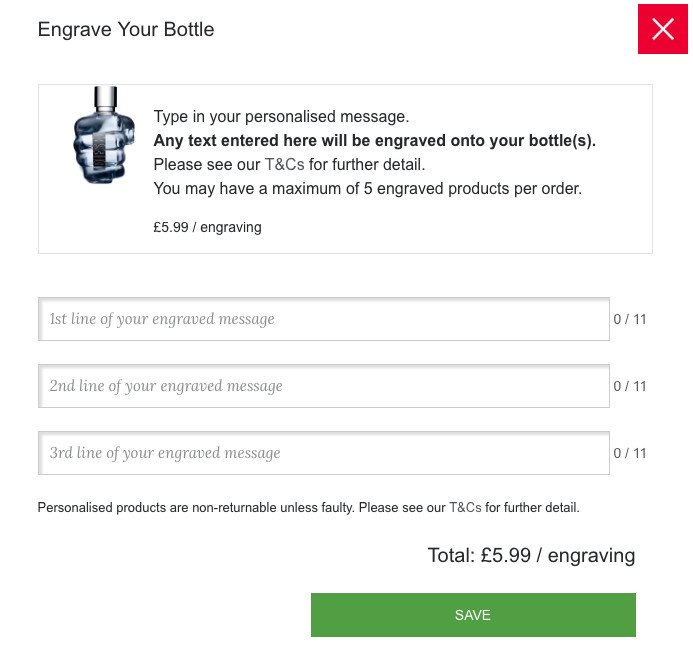
This company gives its customers a chance to get custom engravings on certain bottles.
However, this upgrade comes with an additional cost. But as you saw, customers are willing and able to pay more for customization.
It would be unreasonable for them to expect a premium feature like this to be available at no additional cost.
Incentivize minimum spending thresholds
I talked about minimum spending thresholds earlier. Having a minimum order amount for free shipping eligibility is an example of this strategy.
But free shipping isn’t the only way to encourage higher spending.
You can set up a discount based on spending amounts.
Here’s an example from the Rue21 ecommerce website:
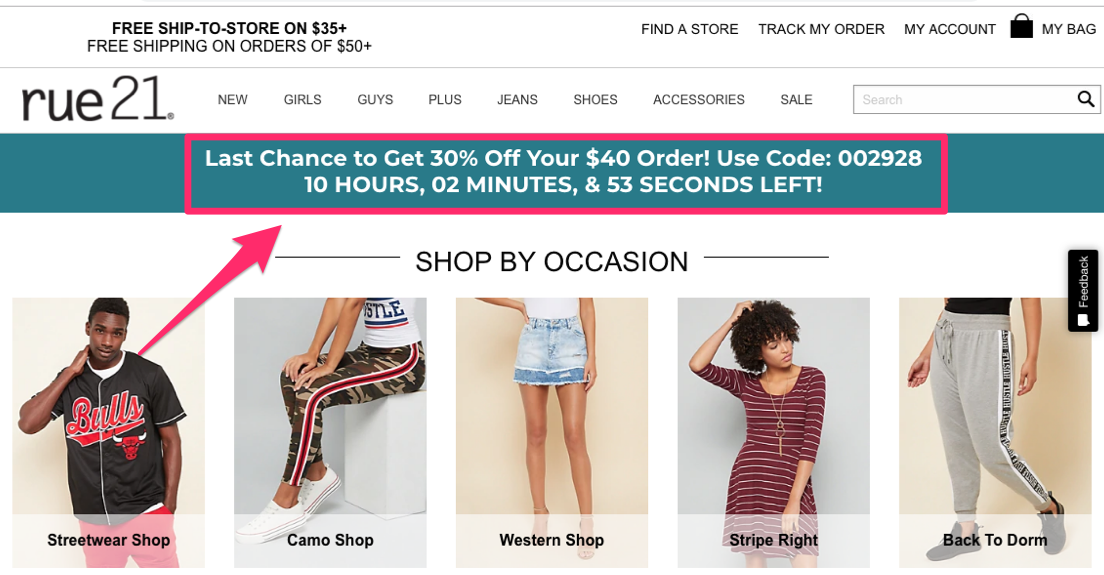
Customers can take advantage of getting 30% off their orders, which is a significant amount.
However, there is a catch. In order to get the 30% discount, they must spend a minimum of $40.
This strategy works well because it also has a deadline.
As you can see, the site has a running clock, indicating when this promotion expires. Customers will feel as though they need to act fast to get this discount before it’s too late.
By combining these two strategies, Rue21 is able to increase its conversion rates while increasing its AOV at the same time.
Use BOGO
Have you heard of BOGO?
BOGO stands for “buy one, get one.” It’s up to you to decide how you want to fill in the sentence after that.
Buy one, get one free. Buy one, get one half off. You’ve got lots of options to choose from.
The reason why BOGO works so well is because it encourages people to spend more money. After all, how could they pass on such a good deal? Here’s what I mean.
If you have a “buy one, get one free sale”, it implies that if someone buys two items, they’ll get two free. If they buy three, they’ll get three free, and so on.
Maurices uses this strategy on its website:

It’s the first thing that you see when you navigate to its ecommerce homepage.
Don’t let BOGO limit your creativity here. You can run similar promotions.
For example, “buy two, get one” free would encourage people to spend even more money.
Either way, this strategy can help you increase your average order value.
Give cash back
Creating a cash back system on your ecommerce site will give people an incentive to spend more money.
The more money they spend, the more cash back they’ll receive. Ultimately, they’ll benefit from these rewards as much as you will. It’s a win-win scenario for everyone.
The Kohl’s cash system is a great example:
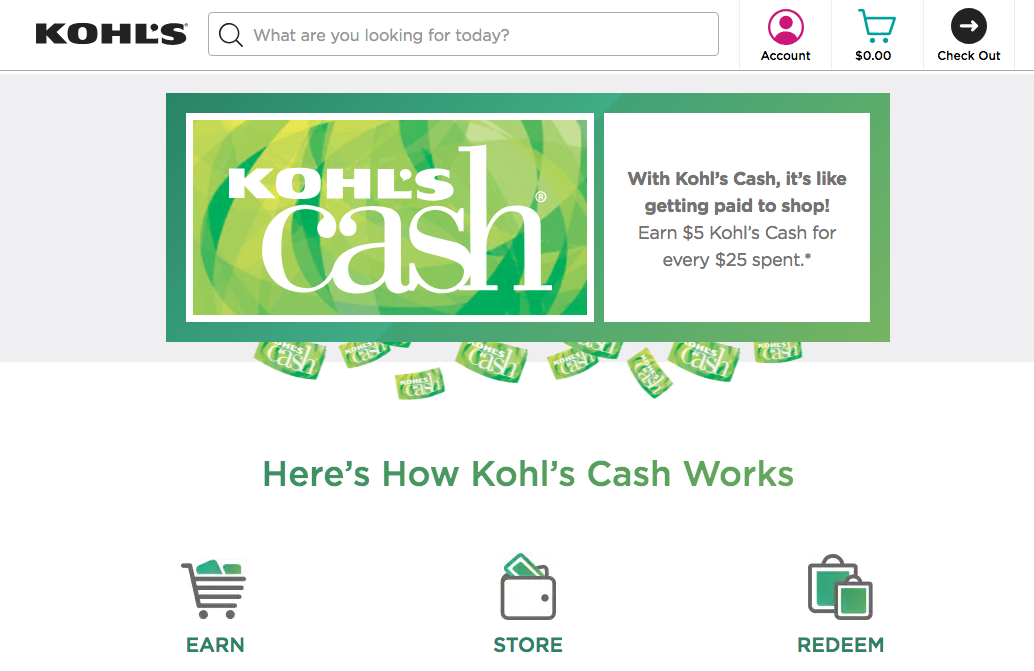
For every $25 a customer spends, they’ll receive $5 in Kohl’s cash.
This promotion is valid on its ecommerce website as well as in its physical stores. If you have brick and mortar shops in addition to your ecommerce platform, you may want to consider a similar structure.
Once customers spend money, they receive Kohl’s cash in the form of a coupon.
These coupons are automatically stored in their customer profiles.
Kohl’s doesn’t have any limit on this spending. If a customer spends $1,000, they’ll get $200 in Kohl’s cash as a reward.
I know what some of you are thinking. If the cash back eventually gets redeemed, wouldn’t it lower the average order value of those future purchases?
Not necessarily. It’s unlikely that people will spend only the amount of their reward on those future purchases. Plus, you can set expiration dates for the cash back rewards, which is what Kohl’s does. There’s a chance not all of these rewards will be used.
Recommend products to your customers
Studies show 58% of consumers are more likely to buy from online retailers who recommend products based on their customers’ purchase histories.
In addition to using information about their previous purchases, you can also use customers’ browsing histories for product recommendations.
This strategy works best if you encourage people to create customer profiles. It makes it easier for you to monitor their behaviors.
It’s also effective if you have a mobile app. In fact, personalized recommendations made my list of the top 10 features of a successful mobile commerce app.
When you recommend products to your customers, it speaks to them. I talked about this earlier when I discussed upselling.
But you don’t need to wait until the customer reaches their shopping cart to offer recommendations. Here’s an example from the Sephora’s website:

In addition to recommending and showcasing its bestsellers, the brand also has a “recommended for you section” on its homepage.
The items displayed will vary depending on who is browsing.
For example, let’s say your ecommerce shop sells sports equipment.
One of your customers recently purchased a new set of golf clubs on your website. The next time they visit your site, you could recommend golf balls, tees, golf spikes, and other similar accessories.
These recommendations will ultimately help you increase your AOV.
Create a loyalty program based on spending tiers
Loyal customers spend more money.
In fact, 82% of consumers are more likely to buy from businesses offering loyalty programs.
Plus, repeat customers spend 67% more money than new customers. That’s why you need to learn how to increase sales by implementing a customer loyalty program.
However, there are many different types of loyalty programs out there.
One of my favorite options is to create a program based on spending tiers. This is the best way to get your existing customers to spend more money each time they shop.
Here’s a look at the Nordy Club benefits, which is a loyalty program from Nordstrom:
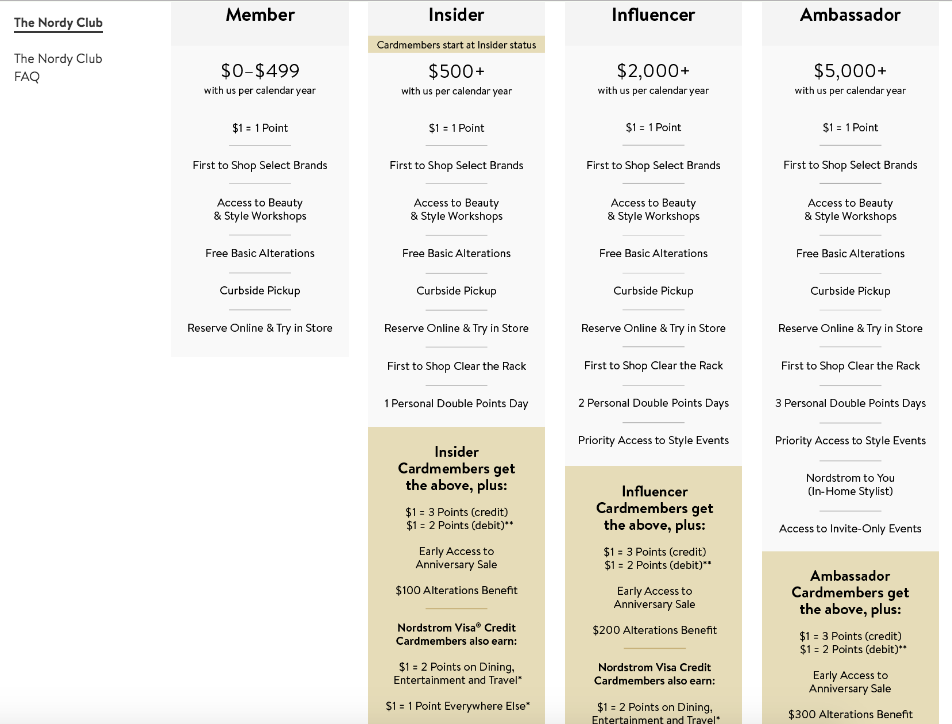
As you can see, the benefits get better as customers reach each spending level within a calendar year. These loyalty programs reward your customers who spend the most money.
For the most part, people probably won’t spend $500 or $2,000 in one purchase.
However, they may be willing to spend an extra $50 or so on each transaction to get them one step closer to the next rewards tier.
By encouraging them to spend more, you’ll increase your average order value.
Conclusion
While new customers are always great for company growth, they are not a requirement for increasing your revenue.
Instead of prioritizing customer acquisition, you should focus on strategies that encourage both your existing and prospective customers to spend more money on your ecommerce site.
The average order value is a metric you should be tracking.
Regardless of your current AOV, I’m confident you can improve that number.
Not sure where to start? Use this guide as a reference.
If you implement the strategies I’ve outlined above, you’ll notice a significant boost in your ecommerce average order value.
What steps is your ecommerce shop taking to increase your AOV?
COntributer : Quick Sprout https://ift.tt/2CDuwuH
 Reviewed by mimisabreena
on
Friday, October 26, 2018
Rating:
Reviewed by mimisabreena
on
Friday, October 26, 2018
Rating:















No comments:
Post a Comment